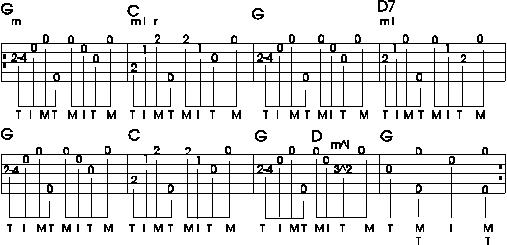
The first note is a "2-4". The "-" means a slide. You start by fretting the third string second fret with your middle finger. Strike the string with your thumb and then slide your middle finger up to the fourth fret.
Each of the measures contain 1\8th notes, except for the last measure which contains 1\4 notes. The "2-4" slide is counted as one 1\8th note so your slide will have to be fast enough as to not give it more value than an 1\8th note. Patting your foot, the "2-4" is played when your foot goes down and the next note, the open second string, is played when you raise your foot. Listen to the sound file below.
Notice the "3^2" in the seventh measure. In this case it means a "pull-off". See the "m^i" above it? This tells you to place your middle finger on the third fret third string and your index finger on the second fret third string. Then after picking the string with your right hand thumb, pull off of the third string with your left hand middle finger leaving your index finger firmly planted, to get the next sound. Some people "push-off" instead of pulling. Try them both to see which you like best. You are actually "picking" the string with you left hand middle finger to get the sound of the third string fretted at the second fret. Notice the "3^2" is an 1\8th note so don't give it more time than required. Again, listen to the sound file if you are confused.
Learn one measure at a time. As you are playing the song and are making the "rolls" think about which chord you are making. If you are making a "C", think "This is a 'C' roll." If you are making a "D", think "This is a 'D' roll", etc.

| Return to Lessons | Return to Index | Return to Beginning of Web Page |